A microelectronic pill, also known as an ingestible sensor or smart pill, is a small, swallowable device that contains sensors and electronics to monitor various aspects of a person's health. These pills are designed to be ingested and pass through the digestive system, where they can transmit data wirelessly to a device such as a smartphone or computer.
The primary function of a microelectronic pill is to monitor and collect data about the body's internal processes. These pills can be used to track various metrics, including pH levels, temperature, and the presence of specific chemicals or drugs in the body. In addition to collecting data, microelectronic pills can also be programmed to release small doses of medications or other substances at specific intervals or in response to certain conditions.
One of the key advantages of microelectronic pills is their ability to continuously monitor the body without the need for invasive procedures or external devices. This can be particularly useful for individuals with chronic conditions that require frequent monitoring, such as diabetes or heart disease. Additionally, microelectronic pills can be used to monitor the effectiveness of certain treatments or to detect early warning signs of potential health issues.
To work, microelectronic pills rely on a combination of sensors, electronics, and wireless communication technology. The sensors, which are typically located on the surface of the pill, are used to collect data about the body. These sensors may include temperature sensors, pH sensors, or sensors that detect the presence of specific chemicals or drugs.
The electronics within the pill are used to process the data collected by the sensors and to transmit the data wirelessly to a device such as a smartphone or computer. This data is typically transmitted using Bluetooth or another wireless communication technology.
One potential limitation of microelectronic pills is their reliance on battery power. Most microelectronic pills are powered by small, rechargeable batteries that must be replaced periodically. Additionally, the wireless transmission of data can potentially be disrupted by interference or other factors, which could affect the reliability of the data collected by the pill.
Despite these limitations, microelectronic pills have the potential to revolutionize the way we monitor and treat various health conditions. By providing continuous, non-invasive monitoring, these pills have the potential to improve patient care and make it easier for individuals to manage their own health. As technology continues to advance, it is likely that microelectronic pills will become an increasingly common tool in the healthcare industry.








